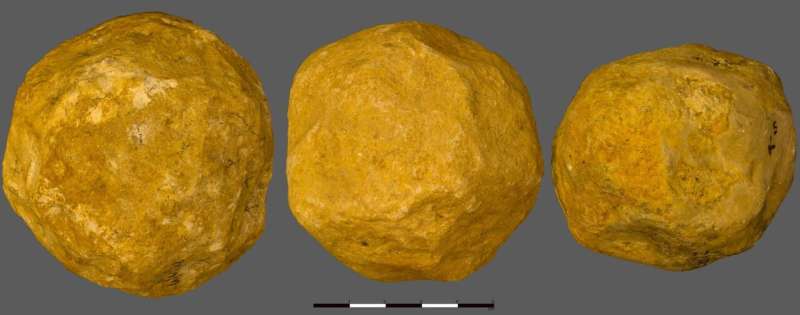This article has been reviewed according to Science X's editorial process and policies. Editors have highlighted the following attributes while ensuring the content's credibility:
fact-checked
peer-reviewed publication
trusted source
proofread
The limestone spheroids of 'Ubeidiya: Intentional imposition of symmetric geometry by early hominins?

Limestone spheroids, enigmatic lithic artifacts from the ancient past, have perplexed archaeologists for years. While they span from the Oldowan to the Middle Paleolithic, the purpose behind their creation remains a subject of intense debate.
Now, a study conducted by a team from the Computational Archaeology Laboratory of the Hebrew University of Jerusalem, in collaboration with researchers from Tel Hai College and Rovira i Virgili University seeks to shed light on these mysterious objects, offering insights into the intentions and skills of early hominins.
Spheroids are among the most enduring yet least understood archaeological artifacts, often considered as by-products of percussive tasks. However, the team's research challenges this conventional wisdom. The central question at the heart of this study is whether these spheroids were unintentional by-products or intentionally crafted tools designed for specific purposes.
To answer this question, cutting-edge 3D analysis methods, including spherical harmonics and surface curvature, were applied to a collection of 150 limestone spheroids from the 'Ubeidiya archaeological site, dating back to approximately 1.4 million years ago. These methods were developed at the Computational Archaeology Laboratory of the Hebrew University, directed by Professor Leore Grosman.
'Ubeidiya is presently recognized as the earliest known Acheulean occurrence outside of Africa, making it a crucial location for investigating the evolution of early hominin technology.
The research team meticulously reconstructed the spheroid reduction sequence based on the trends observed in scar facets and geometry. Their findings revealed a remarkable pattern: the spheroids at 'Ubeidiya were crafted with a premeditated reduction strategy.
Contrary to the notion that they were accidental by-products, the spheroids did not become smoother during their manufacture; instead, they became markedly more spherical. This transformation towards an ideal sphere required exceptional knapping skills and a clear preconceived goal.
This discovery challenges existing beliefs about the capabilities of early hominins and their relationship with technology. While Acheulean bifaces are traditionally thought to represent the earliest evidence of hominins imposing intentional, symmetrical shapes on stone, the intentional production of sphere-like objects at 'Ubeidiya similarly suggests that these early hominins had a desire for and achieved intentional geometry and symmetry in stone.
Slightly older spheroids exist at sites in Africa. If this same intentionality can be demonstrated there, this would represent the oldest evidence of hominins desiring and achieving symmetrical shapes in stone.
The team's research opens new avenues for understanding the cognitive abilities and technological achievements of our distant ancestors. It also raises questions about the purpose and significance of these spheroids in the daily lives of early hominins.
The findings are published in the journal Royal Society Open Science.
More information: The limestone spheroids of 'Ubeidiya: Intentional imposition of symmetric geometry by early hominins?, Royal Society Open Science (2023). DOI: 10.1098/rsos.230671. royalsocietypublishing.org/doi/10.1098/rsos.230671
Journal information: Royal Society Open Science
Provided by Hebrew University of Jerusalem



















